 |
 |
|
As a child I often dreamed of being an archeologist who would discover long lost ruins from ancient civilizations. I hoped to find things like mummies or caves filled with priceless golden treasure.
I loved going to museums and seeing all sorts of ancient artifacts. I begged my family to stop at every roadside place that advertised any such items. My brothers and sisters did not share this enthusiasm. They resorted to all sorts of distractions to keep me from noticing billboards advertising anything resembling a museum while traveling on our family vacations. |
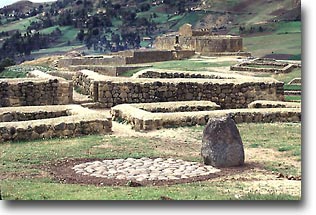 |
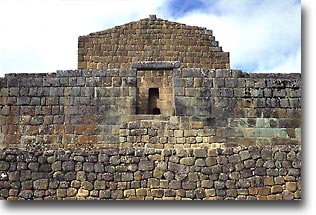 |
I still enjoy visiting museums and seeing ancient sites. I'd like to share some places around Ecuador where you can still discover remnants of ancient civilizations.
Ingapirca is by far the most developed site on display in Ecuador. This site near Caņar has a large oblong structure that exhibits the most developed Incan masonary technique. This style consists of parallel rows of perfectly fit stones that require no mortar. Generally this type of stonework is found in buildings of importance. The site dates from the late 1400's to early 1500's. |
|
There are many Incan sites throughout Ecuador that have not yet been excavated. One can often find trails and remnants of the royal Incan road; parts of which are still in use. Early morning and dusk are great times to look for terraces and walls of fortresses throughout the highlands especially in southern parts of Ecuador.
This path is near San Lucas just south of Saraguro. |
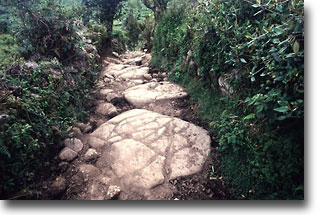 |
 |
Quite often old Incan fortresses have become completely overgrown and can be rather hard to find. I've found some ruins by looking on maps, some by guide books or newspaper clippings, some by looking for terraces at the end of the day and a few by dumb luck. |
|
Caranqui is a small neighborhood near Ibarra. Last year I read a short article about it in the Quito newspaper. Armed with the clipping that included a picture of this Incan wall, I decided I would try to find it.
I soon learned that many people living within a mile or less of the ruins know nothing about it. But in cases like this, persistance pays off and you keep asking until you find it. |
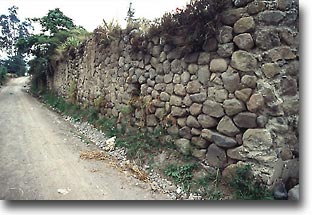 |
 |
I had stopped to ask an elderly lady about the location of the Incan wall that was pictured in the paper. She asked me a few questions and then invited me on to her property to show me something they had discovered while making adobe bricks. Right before my eyes was a long channel carved out of stone blocks that brought water over to a bathlike chamber.
She told me how they had recently found a large funeral pot that had contained a mummy. |
|
She then showed me the hole where the pot had been and I wondered whether they still had it. She assured me that they had given it to an archeologist in Ibarra and that they were negociating to sell the property to preserve the site.
Unfortunately, judging by the piles of stones found on the property, they have already destroyed many of the original walls. As I was leaving, a large front-end loader was there rapidly digging down another 3 or 4 feet of dirt. |
 |
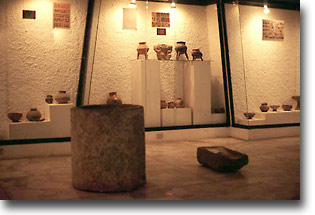 |
There is a museum at Caranqui where you can see many artifacts from the region. Many of which are on loan from local residents. The building itself is a possible model of the temple that was originally located nearby at the present site of the Catholic cathedral. There is some speculation that Caranqui was the home and possible birthplace of Atahualpa; the last Inca who was captured and eventually killed by the Spanish conquistador, Francisco Pizzaro. The are also colorful local legends of ghosts that roam the streets and rumours that priests have dug tunnels underneath the church looking for lost buried treasure. |
|
There are several Incan fortresses in Ecuador that have been partially restored. One is pictured in the Cotopaxi National park section of this site.
The most easily accessed Incan fortress around Quito is near Pomaski. The ruins are a short distance away from the "Mitad del Mundo" equator museum and clearly visible from the top of the monument. The construction of this fortress is similar to that found at Cotopaxi. |
 |
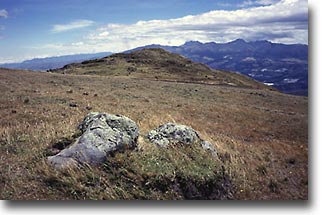 |
I recently found the Incan ruins at Pambarca. Actually there are several fortresses together in a complex. The neat thing about Pambarca is that it is mostly in an unrestored state. One can still see a few sections of walls as they were originally built. It isn't easy to get though as it is located high in the mountains near Cayambe. |
|
There are other Pre-Incan sites around Quito that are worth visiting. The pyramids at Cochasqui are located just past Guayabamba on the new road to Otavalo. They consist of numerous large earthen platforms with long ramps. The pyramids themselves are being left covered with dirt and grass to keep them from deteriorating further.
One can see the original construcion using earthen blocks under a protective layer of tin roofing.
One can also see a previous expeditions attempt to discover treasure in the pyramids. They diverted a stream to cut through the center of one of the largest pyramids. |
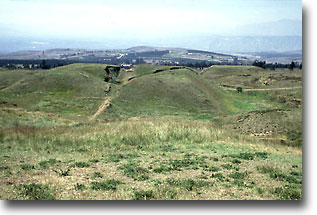 |
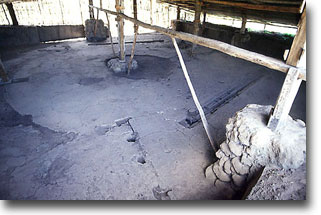 |
Cochasqui is located near the equator and thus allows for a more accurate solar calender or observatory. Many of the Andean tribes placed high importance on following the cycles of the sun. At Cochasqui you can clearly see a solar and lunar calender laid out on top of one of the pyramids. There are holes where pieces of stone were placed and long channels where water was probably added to aid the observation.
While none of the ruins in Ecuador really compare with those in Peru, they are sort of fun to discover since none are well marked. Legends of buried treasure do persist to this day and occasional expeditions of fortuneseekers come searching for gold. I know there are many more Incan ruins out there to be found and I personaly enjoy looking for them each time I drive through the highlands of Ecuador. |